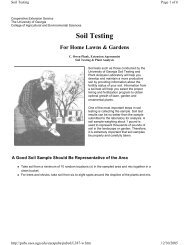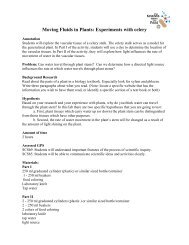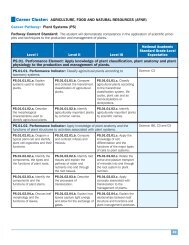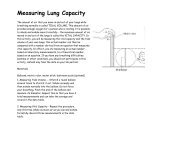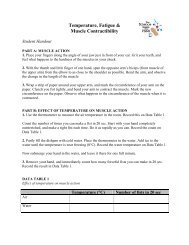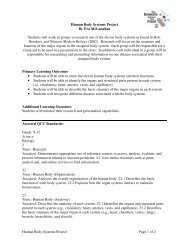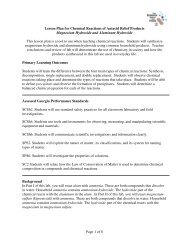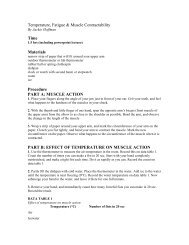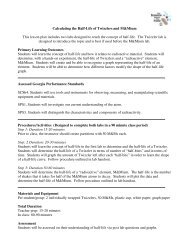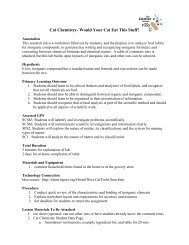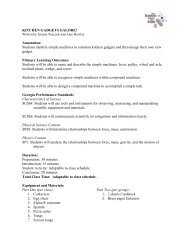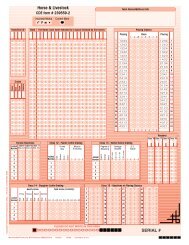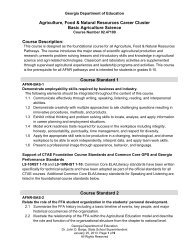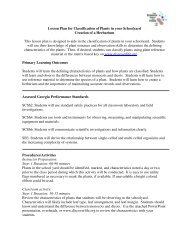How to Use a Clinometer Page 1 of 3
How to Use a Clinometer Page 1 of 3
How to Use a Clinometer Page 1 of 3
Create successful ePaper yourself
Turn your PDF publications into a flip-book with our unique Google optimized e-Paper software.
<strong>How</strong> <strong>to</strong> <strong>Use</strong> a <strong>Clinometer</strong><br />
DOCUMENT<br />
1201<br />
<strong>Page</strong><br />
1 <strong>of</strong> 3<br />
Height, slope and<br />
vertical angle measurements<br />
made easy! A clinometer can be used <strong>to</strong><br />
measure heights <strong>of</strong> trees, poles, <strong>to</strong>wers, and buildings.<br />
You can also use it <strong>to</strong> measure slopes for preliminary surveying,<br />
grade work, and site drainage. Vertical angles can be measured as well<br />
for engineering and surveying projects, satellite and microwave dish installation<br />
and more. The following pages include instructions for using clinometers in<br />
various situations.<br />
43830 Percent and degree scales (±150%, ±90°). Cosines <strong>to</strong> 45° on back.<br />
43895 Percent and <strong>to</strong>pographic scales (±150%, ±200’ @ 66’ baseline). Percent/degree<br />
conversions on back.<br />
43904 Percent and degree scales with built-in rangefinder, target for 50’, 100’ baselines.<br />
Cosines <strong>to</strong> 45° on back.<br />
43831 Percent and degree scales with built-in light. Cosines <strong>to</strong> 45° on back. Battery<br />
included.<br />
43896 Degree and <strong>to</strong>pographic scales (±90°, ±200’ @ 66’ baseline). Cosines <strong>to</strong> 45° on<br />
back.<br />
43893 Degree and <strong>to</strong>pographic scales with built-in rangefinder, target for 66’, 132’ baselines<br />
(±90°, ±200’ @ 66’ baseline).<br />
43897 15m and 20m scales (±35m @ 15m baseline, ±50m @ 20m baseline, respectively).<br />
20m scale/degree conversions on back.<br />
43877 15m and 20m scales with built-in rangefinder, target for 14m and 20m baselines.<br />
(±35m @ 15m baseline, ±50m @ 20m baseline, respectively). 20m<br />
scale/degree conversions on back.<br />
43840 Percent and secant scales* (±150%, secant values x 100 – 100 <strong>to</strong> ±500).<br />
Percent/degree conversions on back.<br />
43832 Degree and secant scales (+90°, cosines 0 <strong>to</strong> 45°).<br />
Note: Since 43840 and 43832 secant scale clinometers express secant <strong>of</strong> a slope<br />
times 100, you should initially divide the clinometer reading by 100 <strong>to</strong> get the correct<br />
secant value. For example, a clinometer reading <strong>of</strong> 110 has a correct secant value <strong>of</strong><br />
1.10.<br />
*Secant scale clinometer 43840 allows you <strong>to</strong> determine correct horizontal distances<br />
and compensate for slope when using the percent scale for height measurements. You<br />
can also eliminate prism rotation in point sampling.<br />
1-800-813-2439<br />
Technical Support<br />
1-800-430-5566<br />
If you need more information or would<br />
like advice from an experienced<br />
pr<strong>of</strong>essional, call our Technical<br />
Support team.<br />
Sales Department<br />
1-800-647-5368<br />
Our friendly Sales Department will<br />
gladly fax you an order form, update<br />
you on pricing, or take your order over<br />
the phone.<br />
Online Sales<br />
For credit card and open account<br />
orders, visit our web site <strong>to</strong> place your<br />
order at www.forestry-suppliers.com.<br />
Forestry Suppliers, Inc. accepts Visa,<br />
MasterCard and American Express.<br />
Forestry Suppliers, Inc.<br />
Starting out as a small forestry supply<br />
company in 1949, Forestry Suppliers,<br />
Inc. now serves a variety <strong>of</strong> resource<br />
management pr<strong>of</strong>essions worldwide.<br />
Today’s Environmental Science,<br />
Agriculture, Engineering, Education,<br />
and Forestry pr<strong>of</strong>essionals count on<br />
us for the specialty items they use<br />
everyday. and we deliver<br />
Our annual catalog features<br />
thousands <strong>of</strong> quality instruments<br />
and supplies for your pr<strong>of</strong>essional<br />
outdoor needs. Best <strong>of</strong> all, just like<br />
our fax on demand service, our<br />
catalog is absolutely FREE and only<br />
a <strong>to</strong>ll-free phone call away.<br />
To discover everything Forestry<br />
Suppliers, Inc. has <strong>to</strong> <strong>of</strong>fer you,<br />
call 1-800-360-7788 and request<br />
your FREE copy <strong>of</strong> our current<br />
catalog. Call <strong>to</strong>day!<br />
Forestry Suppliers, Inc.<br />
205 West Rankin Street US Sales: 800-647-5368 www.forestry-suppliers.com<br />
Jackson, Mississippi 39201 Int’l Sales: (601) 354-3565 e-mail: fsi@forestry-suppliers.com
<strong>How</strong> <strong>to</strong> <strong>Use</strong> a <strong>Clinometer</strong><br />
DETERMINING HEIGHT USING A PERCENT<br />
SCALE CLINOMETER<br />
DOCUMENT<br />
1201<br />
<strong>Page</strong><br />
2 <strong>of</strong> 3<br />
To acquire height measurements with a percent scale clinometer, stand any convenient horizontal<br />
baseline distance from an object in which you can see both the <strong>to</strong>p and bot<strong>to</strong>m <strong>of</strong> the object.<br />
Then sight the <strong>to</strong>p <strong>of</strong> the <strong>of</strong> the object for the <strong>to</strong>p % reading and the bot<strong>to</strong>m <strong>of</strong> the object for the<br />
bot<strong>to</strong>m % reading.<br />
Then follow this simple mathematical formula <strong>to</strong> calculate the height:<br />
% <strong>to</strong> <strong>to</strong>p - % <strong>to</strong> bot<strong>to</strong>m = <strong>to</strong>tal % height<br />
then<br />
<strong>to</strong>tal % height x horizontal baseline distance = height.<br />
Note the following examples as they relate <strong>to</strong> different ground circumstances and horizontal<br />
baseline distances:<br />
Height measurements on level ground and above a tree.<br />
Using the percent scale and horizontal baseline distance convenient for you <strong>to</strong> see both the <strong>to</strong>p<br />
and bot<strong>to</strong>m <strong>of</strong> the tree, follow these simple procedures. Back away from the tree the baseline<br />
distance. In this example, 80’. Sight the <strong>to</strong>p <strong>of</strong> the tree and read the % scale (63%). Sight the<br />
bot<strong>to</strong>m <strong>of</strong> the tree and read the % scale (-7%). Subtract the bot<strong>to</strong>m reading from the <strong>to</strong>p reading:<br />
63% -(-7%) = 70%. To obtain tree height, simply multiply this percentage times your horizontal<br />
baseline distance. 70% x 80’ = 56’ tree height. (See Figure 1.)<br />
Height measurements on sloping ground and below the tree.<br />
Using the percent scale and 100’ horizontal baseline (or other baseline convenient for you <strong>to</strong><br />
see both the <strong>to</strong>p and bot<strong>to</strong>m <strong>of</strong> the tree), follow these simple procedures. When the base <strong>of</strong> the<br />
tree is ABOVE eye level, sight the <strong>to</strong>p then sight the base. Subtract the base reading from the<br />
<strong>to</strong>p reading. This example: 70% - 14% = 56%. Then multiply 56% x 100’ = 56’ (tree height).<br />
(See Figure 2.)<br />
When the base <strong>of</strong> the tree is BELOW eye level, sight the <strong>to</strong>p then sight the base. Subtract the<br />
bot<strong>to</strong>m reading from the <strong>to</strong>p reading. For example,<br />
-10% <strong>to</strong>p reading - (-66% bot<strong>to</strong>m reading) = 56%. Then multiply by 100’ (baseline) for a tree<br />
height <strong>of</strong> 56’.<br />
56'<br />
63%<br />
-7%<br />
80'<br />
Figure 1<br />
14' 14% 56%<br />
100'<br />
Figure 2<br />
1.05<br />
B = 1.05<br />
A = 100'<br />
C = 95.24'<br />
Figure 3<br />
USING A SECANT SCALE CLINOMETER TO DETERMINE:<br />
Horizontal distance on sloping ground.<br />
To find an unknown horizontal distance (C), divide the measured<br />
slope distance (A) by the secant value <strong>of</strong> the slope (B). This example:<br />
100 ft. ÷ 1.05 = 95.24 ft. (horizontal distance). (See Figure 3.)<br />
Correct slope distance for a desired horizontal distance.<br />
Correct slope distance (C) is determined by multiplying the required horizontal baseline distance<br />
(A) times the secant value <strong>of</strong> the slope (B). This example: 100 ft. x 1.05 = 105 ft. (correct slope<br />
distance). (See Figure 4.)<br />
B = 1.05<br />
C = 105'<br />
A = 100'<br />
Figure 4<br />
1.05<br />
Forestry Suppliers, Inc.<br />
205 West Rankin Street US Sales: 800-647-5368 www.forestry-suppliers.com<br />
Jackson, Mississippi 39201 Int’l Sales: (601) 354-3565 e-mail: fsi@forestry-suppliers.com
<strong>How</strong> To <strong>Use</strong> a <strong>Clinometer</strong><br />
DOCUMENT<br />
1201<br />
<strong>Page</strong><br />
3 <strong>of</strong> 3<br />
USING TOPOGRAPHIC & METRIC SCALE<br />
CLINOMETERS TO MEASURE HEIGHT<br />
The <strong>to</strong>pographic scale clinometer is designed <strong>to</strong> measure heights directly in feet when<br />
using a horizontal baseline <strong>of</strong> 66’. Take readings the same way described for the percent<br />
scale clinometer. The <strong>to</strong>pographic scale can also be used at a horizontal baseline <strong>of</strong> 33’<br />
or 132’, but the reading must be halved or doubled, respectively.<br />
The metric scale clinometer is used much the same as the <strong>to</strong>pographic scale clinometer,<br />
in that they both read directly when at the horizontal baseline distance prescribed for<br />
them. The metric scale clinometer reads heights directly in meters.<br />
CLINOMETER SCALES<br />
Each clinometer has two scales which are available in the following combinations:<br />
Percent and Degree, Percent and Topographic, Degree and Topographic, 15m and 20m,<br />
Percent and Secant, or Degree and Secant. Scales are graduated from 0-90° in 1° units;<br />
from 0 <strong>to</strong> 150% in 1% units (0 <strong>to</strong> 70%) then in 2% units (70% <strong>to</strong> 150%). Graduations in<br />
the <strong>to</strong>po scale are 0 <strong>to</strong> ±200’ with a 66’ baseline. Scale readings can be estimated <strong>to</strong> 10<br />
minutes or 1/5%, when readings are made around the zero level.<br />
Measuring Slope<br />
To measure slope, using a percent scale clinometer, sight parallel with the ground (upslope or<br />
downslope) <strong>to</strong> a target, aiming at a point on the target that is equal <strong>to</strong> the height <strong>of</strong> your eye above<br />
the ground.<br />
<strong>Clinometer</strong> Basics<br />
<strong>How</strong> <strong>to</strong> hold and read a<br />
clinometer<br />
Keep both eyes<br />
open when using a<br />
clinometer. <strong>Use</strong><br />
the sight eye <strong>to</strong><br />
look through the<br />
lens at the scales<br />
while the left eye<br />
sights alongside the clinometer housing.<br />
An optical illusion is created and the horizontal<br />
sighting line will appear <strong>to</strong> project <strong>to</strong><br />
the side <strong>of</strong> the clinometer housing. Place<br />
this sighting line on your target and read<br />
the scale.<br />
Which Scale <strong>to</strong> <strong>Use</strong>:<br />
<strong>Clinometer</strong> Required <strong>Clinometer</strong><br />
Scale <strong>Use</strong>d Baseline Distance Reads In<br />
Topo 66 feet feet<br />
15m 15 meters meters<br />
20m 20 meters meters<br />
Any distance % <strong>of</strong> baseline<br />
Percent in feet, yards, distance you<br />
or meters<br />
select<br />
Important Notice<br />
The axes <strong>of</strong> the eyes <strong>of</strong> some people<br />
are not parallel, a condition called heterophoria.<br />
In order <strong>to</strong> be sure that this<br />
doesn’t affect the accuracy <strong>of</strong> readings,<br />
it is suggested that the opera<strong>to</strong>r check<br />
this possibility as follows:<br />
Take a reading with both eyes open<br />
and then close the eye not looking<br />
directly in<strong>to</strong> the clinometer scales. If<br />
the reading doesn’t change appreciably,<br />
there is no disalignment <strong>of</strong> the eye<br />
axes, and both eyes can be kept open.<br />
Should there be a difference in the<br />
readings, one has <strong>to</strong> keep the eye not<br />
looking directly in<strong>to</strong> the clinometer<br />
scales closed and sight partly past the<br />
instrument body making use <strong>of</strong> the<br />
optical illusion.<br />
Forestry Suppliers, Inc.<br />
205 West Rankin Street US Sales: 800-647-5368 www.forestry-suppliers.com<br />
Jackson, Mississippi 39201 Int’l Sales: (601) 354-3565 e-mail: fsi@forestry-suppliers.com



